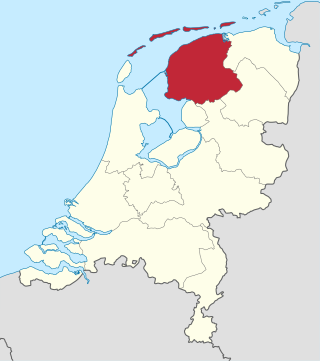
Friesland, historically and traditionally known as Frisia, named after the Frisians, is a province of the Netherlands located in the country's northern part. It is situated west of Groningen, northwest of Drenthe and Overijssel, north of Flevoland, northeast of North Holland, and south of the Wadden Sea. As of January 2023, the province had a population of about 660,000, and a total area of 5,753 km2 (2,221 sq mi).
The Union of Utrecht was an alliance based on an agreement concluded on 23 January 1579 between a number of Dutch provinces and cities, to reach a joint commitment against the Habsburg prince Philip II. By joining forces, they hoped to force him to stop his harsh administrative measures. In addition, some important political matters were regulated in areas such as defence, taxation and religion, which is why the treaty in question is also seen as a first version or precursor of a later constitution. The Union of Utrecht complemented the so-called General Union of 1576, established by the Pacification of Ghent, which is why it is also referred to as the Further Union.
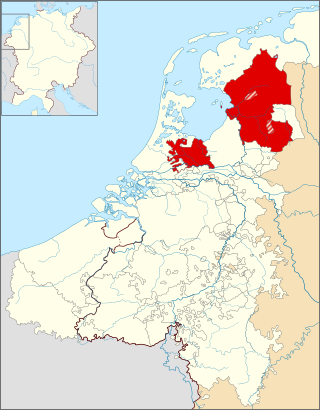
The Bishopric of Utrecht was an ecclesiastical principality of the Holy Roman Empire in the Low Countries, in the present-day Netherlands. From 1024 to 1528, as one of the prince-bishoprics of the Holy Roman Empire, it was ruled by the bishops of Utrecht.
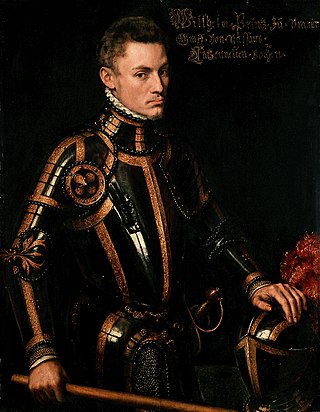
In the Low Countries, a stadtholder was a steward, first appointed as a medieval official and ultimately functioning as a national leader. The stadtholder was the replacement of the duke or count of a province during the Burgundian and Habsburg period.

The Seventeen Provinces were the Imperial states of the Habsburg Netherlands in the 16th century. They roughly covered the Low Countries, i.e., what is now the Netherlands, Belgium, Luxembourg, and most of the French departments of Nord and Pas-de-Calais (Artois). Also within this area were semi-independent fiefdoms, mainly ecclesiastical ones, such as Liège, Cambrai and Stavelot-Malmedy.
The Pragmatic Sanction of 1549 was an edict, promulgated by Charles V, Holy Roman Emperor, reorganising the Seventeen Provinces of the present-day Netherlands, Belgium, and Luxembourg into one indivisible territory, while retaining existing customs, laws, and forms of government within the provinces.

The Act of Abjuration is the declaration of independence by many of the provinces of the Netherlands from their allegiance to Philip II of Spain, during the Dutch Revolt.

The Burgundian Circle was an Imperial Circle of the Holy Roman Empire created in 1512 and significantly enlarged in 1548. In addition to the Free County of Burgundy, the Burgundian Circle roughly covered the Low Countries, i.e., the areas now known as the Netherlands, Belgium and Luxembourg and adjacent parts in the French administrative region of Nord-Pas-de-Calais. For most of its history, its lands were coterminous with the holdings of the Spanish Habsburgs in the Empire.
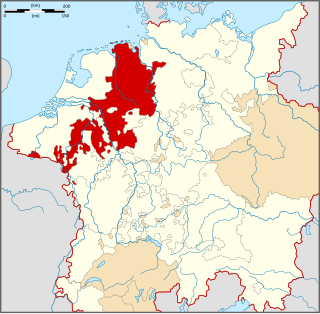
The Lower Rhenish–Westphalian Circle was an Imperial Circle of the Holy Roman Empire. It comprised territories of the former Duchy of Lower Lotharingia, Frisia and the Westphalian part of the former Duchy of Saxony.
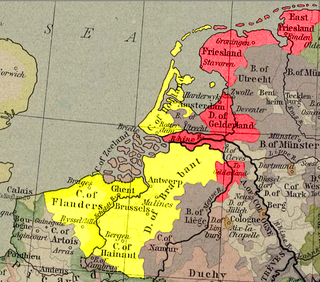
The Guelders Wars were a series of conflicts in the Low Countries between the Duke of Burgundy, who controlled Holland, Flanders, Brabant, and Hainaut on the one side, and Charles, Duke of Guelders, who controlled Guelders, Groningen, and Frisia on the other side.
The Drenther Crusade was a military campaign launched against the inhabitants of Drenthe with the approval of the Papacy in 1228 and lasting until 1232. It was led by Willibrand, Bishop of Utrecht, commanding an army composed mostly of Frisian crusaders.

Habsburg Netherlands was the Renaissance period fiefs in the Low Countries held by the Holy Roman Empire's House of Habsburg. The rule began in 1482, when the last Valois-Burgundy ruler of the Netherlands, Mary, wife of Maximilian I of Austria, died. Their grandson, Emperor Charles V, was born in the Habsburg Netherlands and made Brussels one of his capitals.
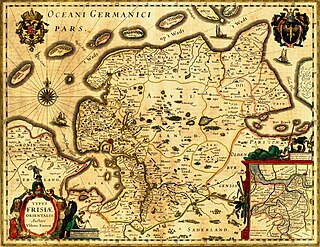
The County of East Frisia was a county in the region of East Frisia in the northwest of the present-day German state of Lower Saxony.

The Lordship of Groningen was a lordship under the rule of the House of Habsburg between 1536 and 1594, which is the present-day province of Groningen.
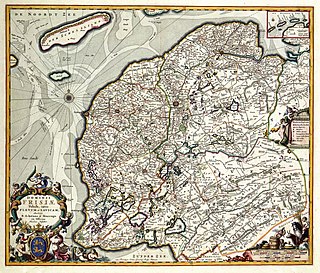
The Lordship of Frisia or Lordship of Friesland was a feudal dominion in the Netherlands. It was formed in 1498 by King Maximilian I and reformed in 1524 when Emperor Charles V conquered Frisia.

The Lordship of Overijssel or Overissel is a former division of the Netherlands named for its position along the river IJssel. It corresponds to the modern day province of Overijssel.

The Lordship of Utrecht was formed in 1528 when Charles V of Habsburg conquered the Bishopric of Utrecht, during the Guelders Wars.
Quaedam narracio de Groninghe, de Thrente, de Covordia et de diversis aliis sub diversis episcopis Traiectensibus, usually just Quaedam narracio for short, is an anonymous Latin prose chronicle written in 1232–33 by a Frisian clergyman attached to Bishop Willibrand of Utrecht. It was written during the Drenther uprising of 1227–1232.
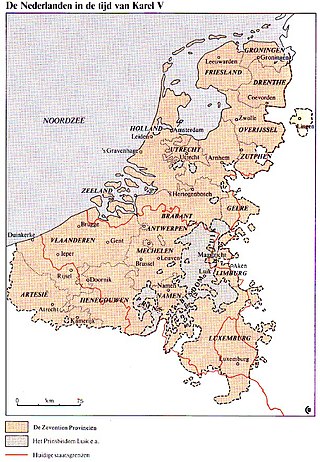
Gewest is a Dutch term often translated as "region". It was used to describe the various different polities making up the Low Countries, which covered what is now the Netherlands, Belgium, Luxembourg and parts of northern France, until the annexation by France in the late 18th century. The term is now mostly associated with the official titles of the constituent states of Belgium.
















